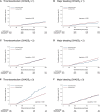Oral anticoagulation after atrial fibrillation catheter ablation: benefits and risks
- PMID: 38117227
- PMCID: PMC10873714
- DOI: 10.1093/eurheartj/ehad798
Oral anticoagulation after atrial fibrillation catheter ablation: benefits and risks
Abstract
Background and aims: Few recent large-scale studies have evaluated the risks and benefits of continuing oral anticoagulant (OAC) therapy after catheter ablation (CA) for atrial fibrillation (AF). This study evaluated the status of continuation of OAC therapy and the association between continuation of OAC therapy and thromboembolic and bleeding events according to the CHADS2 score.
Methods: This retrospective study included data from the Japanese nationwide administrative claims database of patients who underwent CA for AF between April 2014 and March 2021. Patients without AF recurrence assessed by administrative data of the treatment modalities were divided into two groups according to continuation of OAC therapy 6 months after the index CA. The primary outcomes were thromboembolism and major bleeding after a landmark period of 6 months. After inverse probability of treatment weighting analysis, the association between OAC continuation and outcomes was determined according to the CHADS2 score.
Results: Among 231 374 patients included, 69.7%, 21.6%, and 8.7% had CHADS2 scores of ≤1, 2, and ≥3, respectively. Of these, 71% continued OAC therapy at 6 months. The OAC continuation rate was higher in the high CHADS2 score group than that in the low CHADS2 score group. Among all patients, 2451 patients (0.55 per 100 person-years) had thromboembolism and 2367 (0.53 per 100 person-years) had major bleeding. In the CHADS2 score ≤1 group, the hazard ratio of the continued OAC group was 0.86 [95% confidence interval (CI): 0.74-1.01, P = .06] for thromboembolism and was 1.51 (95% CI: 1.27-1.80, P < .001) for major bleeding. In the CHADS2 score ≥3 group, the hazard ratio of the continued OAC group was 0.61 (95% CI: 0.46-0.82, P = .001) for thromboembolism and was 1.05 (95% CI: 0.71-1.56, P = 0.81) for major bleeding.
Conclusions: This observational study suggests that the benefits and risks of continuing OAC therapy after CA for AF differ based on the patient's CHADS2 score. The risk of major bleeding due to OAC continuation seems to outweigh the risk reduction of thromboembolism in patients with lower thromboembolic risk.
Keywords: Atrial fibrillation; CHADS2 score; Catheter ablation; Oral anticoagulation therapy.
© The Author(s) 2023. Published by Oxford University Press on behalf of the European Society of Cardiology.
Figures




References
-
- Chen S, Pürerfellner H, Meyer C, Acou WJ, Schratter A, Ling Z, et al. Rhythm control for patients with atrial fibrillation complicated with heart failure in the contemporary era of catheter ablation: a stratified pooled analysis of randomized data. Eur Heart J 2020;41:2863–73. 10.1093/eurheartj/ehz443 - DOI - PubMed
-
- Packer DL, Mark DB, Robb RA, Monahan KH, Bahnson TD, Poole JE, et al. Effect of catheter ablation vs antiarrhythmic drug therapy on mortality, stroke, bleeding, and cardiac arrest among patients with atrial fibrillation: the CABANA randomized clinical trial. JAMA 2019;321:1261–74. 10.1001/jama.2019.0693 - DOI - PMC - PubMed
Publication types
MeSH terms
Substances
Grants and funding
LinkOut - more resources
Full Text Sources
Medical
Miscellaneous

